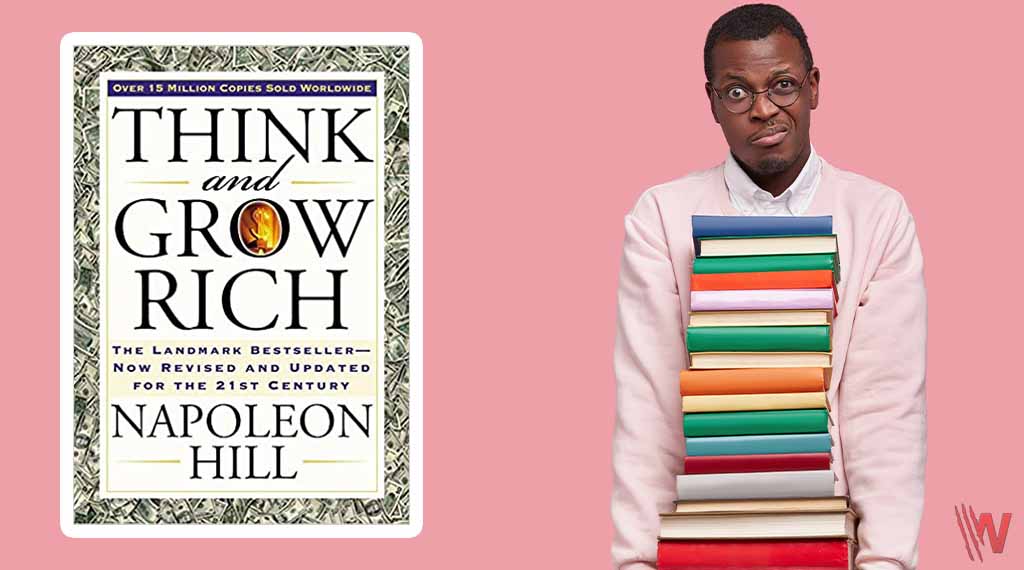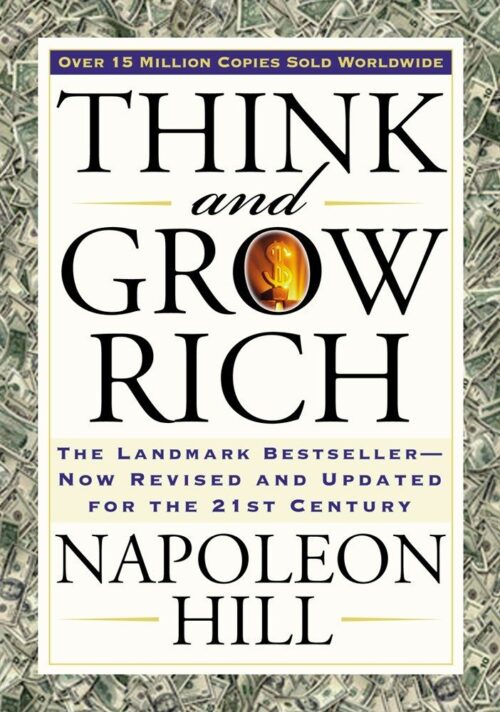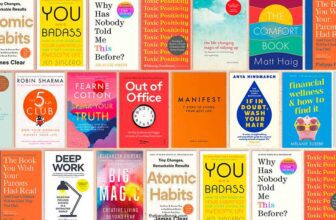If you are seeking to achieve a particular goal in life, whatever it may be, need an exemplary guide in subconscious influence and emotional mastering, or simply want to see what a #1 best-selling non-fiction book of all time has to offer, Napoleon Hill’s Think and Grow Rich offers the information you likely need to transform your life. Napoleon Hill has long been renowned as a master guru of self-help, and he used his all-time best-seller as a Law of Attraction cornerstone.
You may be conflicted on whether this book is worth your time or if it will truly help transform your dreams into achievements. That is a fair skepticism to have about any text that claims to be so impactful. But perhaps there is a reason for all the hype.
The truth is that Think and Grow Rich hits on all the key ingredients of a masterful bestseller in any genre. It effectively checks off multiple categories that explain why it has become a self-help literary giant, just like the wealth-building principles outlined in The Richest Man in Babylon.
- It has an attention-grabbing title
- Makes grand, life-changing claims with stories and quotes to back them up
- Testimonials from notable figures from business titans and former US presidents
- Expert control for emotions and logical flow for the readers
- Tons of inventories and models
- Step-by-step action plans and helpful questionnaires
- Logical explanations of bedrock principles rooted in a lifetime of in-depth research and analysis
All of these make a recipe for a best seller, but in terms of what the book offers as its core ideas, it follows the themes of “reaping what you sow, sowing what you do, doing what you are, and being what you think.” In other words, you are the master of your own thoughts.
Hill dismisses the excuses offered by many people for not being successful in their achievements including having hard lives, lack of education and opportunities, lack of financial stability, or simply not knowing where to start. Hill posits that to master the world, one must master themselves first, and that is something that, he argues, anyone can do. All it takes is some faith, a positive outlook, and ample practice.

Those looking for quick answers can go right to the book’s methodology portion, looking at the 7-step guide, 2 questionnaires, and 20 inventories (at least). Regardless of one’s objective, whether they are to achieve an intended purpose, develop a mastermind, get a perfect job, or build self-confidence, the book’s section offers plenty of material to help develop a person into one they wish to be.
If you are interested in reading the text but want to have a better idea of what to expect, or perhaps you would rather just get some of the main points of it as a substitute, we are here to offer you this interesting and helpful summary of Napoleon Hill’s self-help masterpiece Think and Grow Rich.
Think And Grow Rich: A Summary
Think and Grow Rich
As a servant of bodily actions and the center of mental creativity, the subconscious is normally occupied with attending to basic human needs and keeping us alive. But if one was to tap into it with a conscious purpose, the subconscious can be leveraged to achieve any desired goal. This is the primary thesis at the center of Think and Grow Richby Napoleon Hill.
While communication between the conscious and the subconscious is perpetual, it is also its main bottleneck. It is when we are able to force a two-way dialogue between the two that we can truly tap into the formula for success. Autosuggestion is what the conscious must be used to engage and direct the subconscious into communicating with comprehensible language. When the subconscious can provide its invaluable feedback, it is up to the conscious to learn how to listen, absorb, and support the information.
Subconscious Engagement
So how does one engage the subconscious? To do so, the subconscious must be softened and made to be suggestible by learning to utilize strong emotional states that allow for it to be created or taken over.
Emotional State Creation
There is an important distinction between emotions and emotional states. While emotional states can be thought of as a brightness spectrum of light, the emotion itself is the color filter of that light. The tints and twists that lead to its ultimate shine are the keys. Emotions can be positive (belief, sex, love, romance, hope, desire, and enthusiasm) or negative (fear, hatred, anger, greed, jealousy, revenge, anger, and superstition).
By triggering strong emotions repeatedly, a person creates powerful emotional states (such as passion. The triggers can be internal (prayer, memory, affirmation, visualization, etc.) or external (such as music, imagery, objects, or events). As long as you know what they are and how to locate them, they can be used to construct emotional states. For instance, talking to a person you like can create happiness, while repeating affirmations like “I can do this” leads to the conviction of “I CAN do this!” ultimately translating to the emotion of belief.
But emotional states don’t always need emotional triggers to manifest. Sometimes we let our emotional state follow the alteration of our physical one. Physical triggers such as stress, fatigue, meditation, alcohol, drugs, or fasting are harmful, however, and while they do create emotional states, they don’t have much staying power. That means that there is little control over these emotional states, which means that the results can be tragic, incurring a high cost, which is not always paid just by the person with these triggers, but sadly, by others in their lives.
Emotional State Hijacking
Once an emotional state arises, the real secret is to master it. That is done through a process of hijacking it through sublimation and substitution. With sublimation, we maintain the emotion’s brightness and coloration, while refocusing the action. In other words, it is the skill, acquired through practice, of channeling any emotion into the desired action. Emotions like desire and sex can be channeled into athletics and art.
Sublimation requires a significant focus mastering, in which we override the emotion’s primal tendency to preserve it on the focus. The second component of sublimation is the direction of energy externally. The final component is to be able to do this repeatedly, toggling the energy between its trigger and its desired target.
Much like sublimation, substitution requires a great deal of focus, but instead of refocusing the actions, we willfully focus on those triggers that produce the response we desire. Love, for instance, can be focused on from passionate anger. With substitution, the new emotions override the source of an old one. Without proper focus, the substitution becomes suppression, a far more unsustainable and exhausting strategy for coping with emotions.
Mastering Emotion
When substitution and sublimation are utilized in tandem, they are the most effective. The nature of an emotion fundamentally (though discreetly) changes both outlooks and actions. That is why negative emotions, while strong, end up having negative effects on ourselves and our surroundings. Therefore, approaching negative emotions most effectively is generally done by substituting, and then sublimating. Similarly, on the positive side, positive emotions can be channeled into the most productive results.
The mastery of creation, sublimation, and substitution is otherwise referred to as the mastery of emotions, a pivotal aspect of softening the subconscious and making it suggestible. Once it is softened, you are ready to deliver the desired messages to it.
Directing Subconsciousness
The subconscious understands one language very clearly: visualization or the imagining of events and results into a state that feels so real that we can sense how those results would make us feel. Some examples of such realistic sensations and perceptions are mirages, hallucinations, and lucid dreams. Visualization is a very common technique in many aspects of mediation and psychological performance, most of us are really not great at it, though with practice we can all quickly improve.
Visualization Exercise
Humor yourself with the following exercise. Set a timer for 60 seconds, shut your eyes, and imagine a very familiar place that is filled with great memories. Rather than pushing yourself into it, try to let the space you are seeing materialize and expand your mental picture. As it does so, look and walk around it mentally, perceiving the space from a variety of angles and viewpoints.
Now, think about whether you found this task simple or difficult, if you had to force the visualization, or if it was entirely organic. What space did you see and how did being in it make you feel? It’s possible this exercise was difficult or it gave you a rough sensation. It is possible that you even found it hard to focus for the entire minute.
However, if you do this exercise daily, the visualizations that manifest will become clearer, deeper, and fuller. You will begin to see patterns and colors, fill in the details, and even recall various sensations and textures. The more you perform this exercise, the more your focus will improve, allowing you to perform it for lengthier time periods.
Visualization Of Abstract Concepts
Clarity, repetition, and detail are the three pertinent keys to visualization, though when the concepts in question are objectives, goals, or other imagined and abstract concepts, visualization is harder. One method of overcoming such challenges is writing a clear description of the desired outcomes. While writing is involved, the true purpose is not the words you list, but rather the images and feelings that these words facilitate, allowing you to make them repeatable.
Think about reading a well-written book. As you read the words of a talented author, the words themselves take a backseat, while the characters and locations become real in your mind. You begin to “see” and “hear” them, sense them, and eventually, feel them. That is due to their writing being clear, consistent, and specific, which is exactly the effect you are going for in terms of being able to write down and visualize your ultimate objectives. The desire that you feel is the emotional state that will help you, with repetition, to imprint the image into your subconscious.
Hill hits every one of these points in this six-step central process, asking the reader to write an exact and clear vision of specifically what he or she seeks to obtain. He suggests that we see ourselves in possession of money that is so real that we can feel and smell the paper in our hands. By building this intense, unrelenting desire, he hopes that we will build a strong emotional state. That is precisely the visualization that is our tether to our subconscious.
Autosuggestion Is Direction Plus Engagement
We are primed by these visualization combinations and it is how we put the subconscious to work, directing it to see and act with a subtlety that cannot be emulated by our conscious mind. That is because the subconscious thoughts are creative and not linear, applying these approaches to crafting solutions for problems all the time, including during our sleep cycles. Therefore, the pairing of visualization and emotional mastery results in autosuggestion.
If our subconscious mind is substituted with the subconscious minds of others, it becomes persuasion, and substituting it with an organization, drives the leader’s subconscious into leadership. Why is that you think certain marketers, organizers, and leaders are so effective? It is because they are trained in or innately sensed in the manipulations, sublimation, and substitution of emotions.
In other words, they know how to put ideas into the minds of others, to get them to work on those tasks that they deem important. This part-liberating and part-humbling insight lies at the very core of Think and Get Rich.
Setting Up A Succesful Subconscious
So what then, is the next step once the subconscious has been connected to and directed? According to Hill, the next step is to get out of the way and support the subconscious operation through the conscious mind. This is done in one of 7 ways:
- Subduing the noise: Rather than working on our problems through pointless mental chatter, we can step back and allow our subconscious the bandwidth and time to work on our problems. In other words, the conscious mind can intervene judiciously without getting caught up in chaos.
- Listening: The conscious is told what it needs but the subconscious which is driven by inspiration and emotion. For the conscious to comprehend subconscious messaging we need to listen carefully. Listening is not just to emotion, but to our body and the inspiration fed from it. Is there tension or heaviness wearing you down? Is there anything that makes you feel more lighthearted? These manifestations are usually stemming from a conflict between your thoughts and your emotions. Rather than suppressing the emotions, address them, as they are usually right. With inspiration, rather than rejecting it as unattainable or foolish, listen to it. When the “aha!” moment arrives, seize it and observe the conditions that got you to it so you can recreate these gifts from your subconscious later.
- Problem-Solving: While the subconscious outputs creative solutions, it doesn’t always do so in a rational or organized manner, which is where the conscious mind makes a perfect partner since it is great at organizing and sorting out information in logical sequences. This is especially important for things like planning, and other time-sensitive activities.
- Learning: Both the subconscious and the conscious are using and are bound by knowledge, though they operate differently. While the subconscious learns from emotions and sensations, the conscious collects the information in a coded language and compiles it into factual stories. The latter is pivotal since it lets us learn vicariously, rather than focusing solely on our own experiences.
- Training: The subconscious operates based on habit, while the conscious breaks habits by intervening repeatedly between stimulation and the response to it, until a pattern is trained into it. This intervention is often referred to as willpower or self-awareness.
- Reassurance: In terms of controlling the subconscious, there is no more powerful negative emotion than fear. Hill notes that humans fear death, old age, poor health, poverty, loss of love, and criticism. The conscious, however, is there to reassure the subconscious through belief, acceptance, and action. It is said: “Do the thing you fear and the death of fear is certain.”
- Protection: The subconscious and the conscious are constantly in competition for control of the subconscious. The subconscious operates based on many external influences, some negative, and some positive. Since the subconscious is more vulnerable, the conscious must understand when to kick into protective mode, countering the negative factors influencing its subconscious counterpart, and remove it from the environment with said negative influences.
You might question which of these is most important, and the answer is “listening” to your subconscious, and it starts by stepping back to allow it to “speak.” You may find this to be a difficult task, and there is a good chance you won’t even know that you are sensing the right thing, but don’t despair. It takes a lifetime to master such recognition. Hill’s various step-by-step guides, inventories, and checklists offer a lot of information to get things started.
The Methodology
Napoleon Hill states: “The major reason why I wrote this book on how to get money is the fact that the world has but lately passed through an experience that left millions of men and women paralyzed with the fear of poverty. ”Think and Grow Rich ” would go on to become the world’s best non-fiction seller of all time. As they say, the book title is what sells, not its content. Though in this case, the book delivers on both fronts.
It presents clear, direct, and simple methods for people to acquire financial prosperity. However, the principles in it are not for financial gain alone, but can really be applied to seeking out and achieving nearly any desired outcome.
To summarize, Hill’s recommended approach to financial success comes down to 10 basic steps:
- Define a purpose: Write down a specific, clear, and realistic amount of money you want to have and when you want to acquire it.
- Store it in your subconscious: Visualize the goal you wrote down twice a day, fanning the flames of your desire to achieve it.
- Believe in it: Be confident in yourself, overcome fear, and trust that with the above principles applied, you can achieve your goals.
- Plan it out: Write down your plan to achieve your purpose and begin work on it immediately. Don’t think about needing to get ready, you can do that as you learn more about it.
- Acquire all necessary learning: The wise know what they don’t know, and by accepting that we don’t know everything, we can figure out what we need to know and work on learning those things from people around us who possess that knowledge.
- Garner support: Get together with like-minded, motivated individuals (the Master Mind) in order to cooperate and share knowledge.
- Get help when needed: Harmoniously meet with the Master Mind.
- Assure a successfully functioning subconscious: Take a step back and pay attention to your subconscious. Support and protect it as it works its creative juices.
- Build character: Hone your focus, learn not to be impulsive, and assume habits and characteristics necessary to achieve your ultimate desired end goals.
- Don’t give up: Failure doesn’t exist, there are only setbacks. Remember to learn from every setback and do not repeat learned mistakes as you try again.
Think And Grow Rich: In Summation
The messages of Think and Grow Rich are straightforward: you will get what you work for and only you are the ultimate commander of your thoughts. Hill put a lifetime of study into his work, but his ultimate takeaway is that whether your goal is to be wealthy, bring meaningful change to the world’s society, or find your inner peace, the only place to start the process is from the inside.
You are dealt a certain hand in life and the rules of the game are set in place, so you are forced to play within their confines. But that doesn’t mean you can’t be the game’s best player. All you need is a thought, and the decision to have the thought belongs to you and you alone.
Frequently asked questions:
when was think and grow rich written?
Think and Grow Rich is a self-help book written by Napoleon Hill and published in 1937.
what is the secret in think and grow rich?
Think and Grow Rich is a self-help book that outlines 13 principles for success. The “secret” of the book is the idea of visualizing and believing in one’s goals, which will then attract the necessary resources and opportunities to achieve them.








